The annual average inflation of Cagayan Valley for 2024 eased to 3.4 percent, which was lower than the 2023 annual average inflation rate of 4.6 percent. (Figure 1)
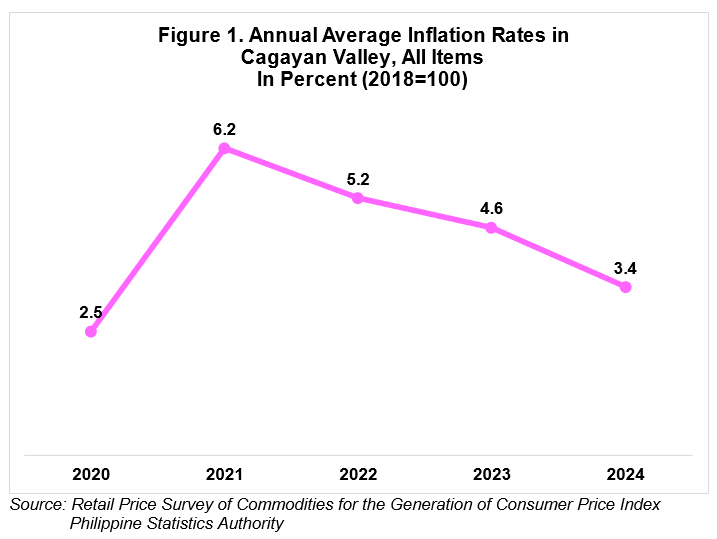
The downtrend in the region's annual average inflation rate for 2024 was primarily driven by the lower annual average increase in the index of food and non-alcoholic beverages, which dropped to 4.8 percent in 2024 from 7.5 percent in 2023.
Additionally, the decline in the annual average inflation rates for housing, water, electricity, gas, and other fuels, which dipped to -0.5 percent from 0.8 percent, and for alcoholic beverages and tobacco, which decreased to 4.7 percent from 11.2 percent in 2023, also contributed to the overall downtrend.
Moreover, lower annual averages were also noted in the indices of the following commodity groups in 2024 compared to 2023:
• Furnishings, household equipment and routine, 4.2 percent from
6.3 percent;
• Personal care, and miscellaneous goods and services, 4.5 percent from 5.6 percent;
• Clothing and footwear, 4.1 percent from 5.1 percent;
• Health, 2.4 percent from 3.0 percent;
• Information and communication, 0.1 percent from 0.6 percent; and
• Financial services, -0.1 percent from 0.0 percent.
On the contrary, higher annual average increase was observed in the indices of the following commodity groups in 2024:
• Transport, 0.3 percent from -1.5 percent;
• Recreation, sport and culture, 8.3 percent from 6.6 percent;
• Education services, 3.5 percent from 2.7 percent; and
• Restaurants and accommodation services, 7.4 percent from
3.2 percent.
The top three commodity groups contributing to the 2024 annual average inflation of Cagayan Valley were the following:
a. Food and non-alcoholic beverages, with 61.7 percent share or contributing 2.1 percentage points;
b. Restaurants and accommodation services, with 17.2 percent share or contributing 0.6 percentage points; and
c. Personal care, and miscellaneous goods and services, with 6.4 percent share or contributing 0.2 percentage point.
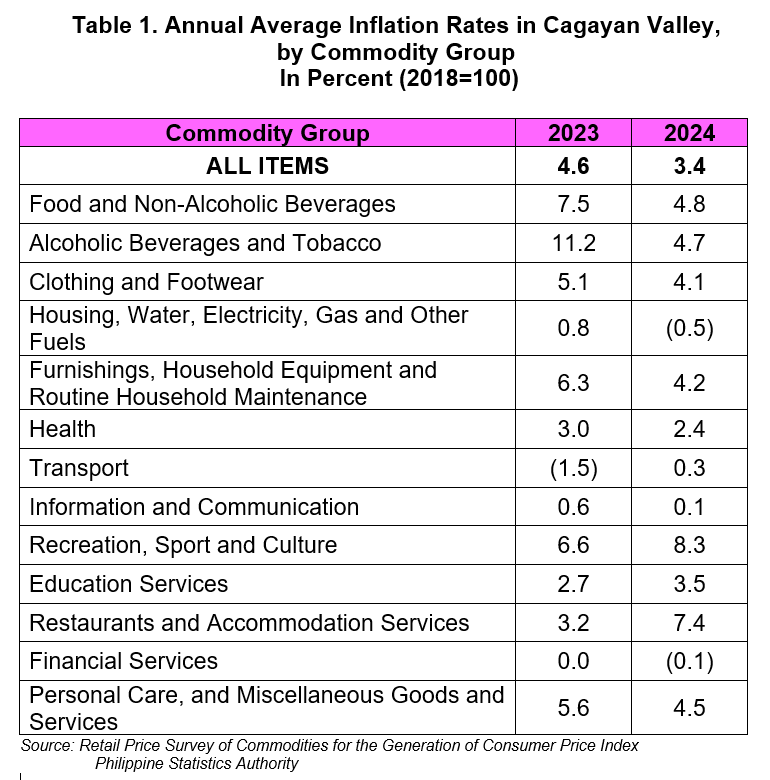
The annual average food inflation in Cagayan Valley went down to 4.9 percent in 2024 from 7.6 percent, in 2023.
The deceleration of annual average food inflation in 2024 was mainly influenced by the lower inflation rate of vegetables, tubers, plantains, cooking bananas and pulses with an annual average of -3.0 percent in 2024 from 22.4 percent in 2023. This was followed by fish and other seafood at 2.2 percent from 7.4 percent and sugar confectionery and deserts, with an annual average inflation rate of -7.0 percent from
19.9 percent.
Moreover, lower annual average inflation rates during the year were noted in the following food groups:
• Milk, other dairy products and eggs, 3.7 percent from 10.4 percent;
• Oils and fats, -2.2 percent from 2.1 percent;
• Fruits and nuts, 2.7 percent from 4.8 percent;
• Flour, Bread and Other Bakery Products, Pasta Products, and Other Cereals, 4.0 percent form 6.1 percent; and
• Corn, 12.6 percent from 19.5 percent.
In contrast, higher annual average inflation rates in 2024 compared to 2023 were observed in the indices of the following food groups:
• Rice, 17.2 percent from 10.8 percent;
• Meat and other parts of slaughtered land animals, 1.8 percent from -1.2 percent; and
• Ready-made food and other food products n.e.c., 6.9 percent from 5.9 percent.
The average annual food inflation shared 60.2 percent or 2.1 percentage points to the overall annual average inflation in 2024. The top three food groups in terms of contribution to the annual average food inflation during the year were the following:
a. Cereals and cereal products, which includes rice, corn, flour, bread and other bakery products, pasta products, and other cereals, with a share of 84.1 percent;
b. Meat and other parts of slaughtered land animals, with a share of 6.8 percent; and
c. Ready-made food and other food products n.e.c., with a share of
6.4 percent.
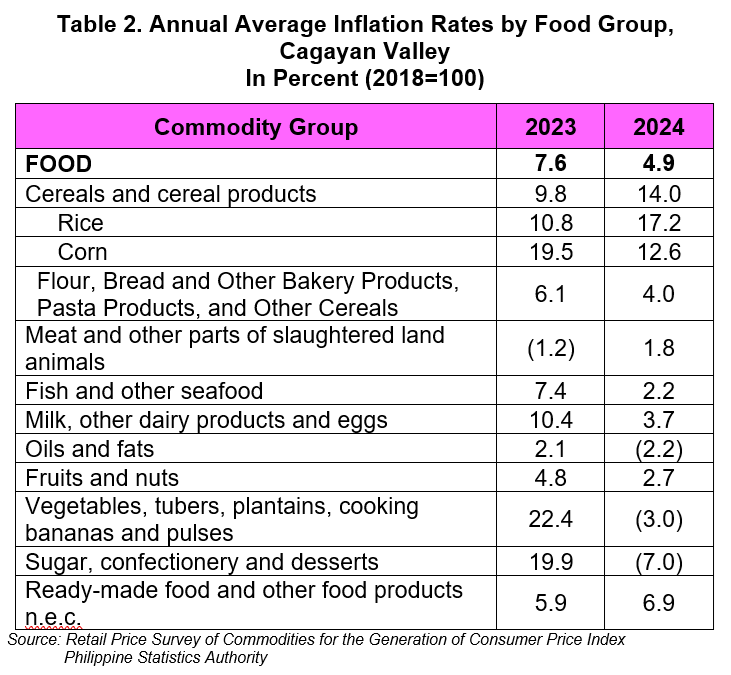
All provinces showed a decrement in their annual average inflation rates during the year in review. The Province of Cagayan recorded the highest annual average inflation among five provinces with 4.7 percent annual average inflation in 2024 from 6.1 percent in 2023. Meanwhile, Isabela posted the lowest annual average inflation rate, with 2.3 percent inflation in 2024 from 3.1 percent in the previous year. (Table 3)
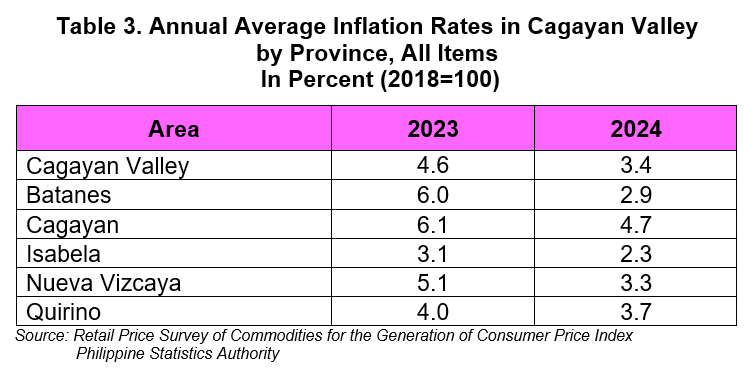
The Province of Cagayan posted the highest percent share to the lower annual average inflation rate of the region with 42.6 percent. The lower inflation rate of the province was observed in the indices of the following commodity groups:
• Food and non-alcoholic beverages, 5.0 percent from 8.3 percent;
• Alcoholic beverages and tobacco, 5.7 percent from 11.6 percent;
• Housing, water, electricity, gas and other fuels, 1.9 percent from
2.7 percent;
• Transport, 1.0 percent from 2.4 percent;
• Clothing and footwear, 7.0 percent from 10.0 percent;
• Personal care, and miscellaneous goods and services, 7.3 percent from 7.6 percent;
• Health, 3.4 percent from 3.8 percent; and
• Furnishings, household equipment and routine household maintenance, 6.2 percent from 6.5 percent.
The rest of the commodity groups in the province either remained at their previous year’s annual average inflation rates or had higher annual average growth rates.
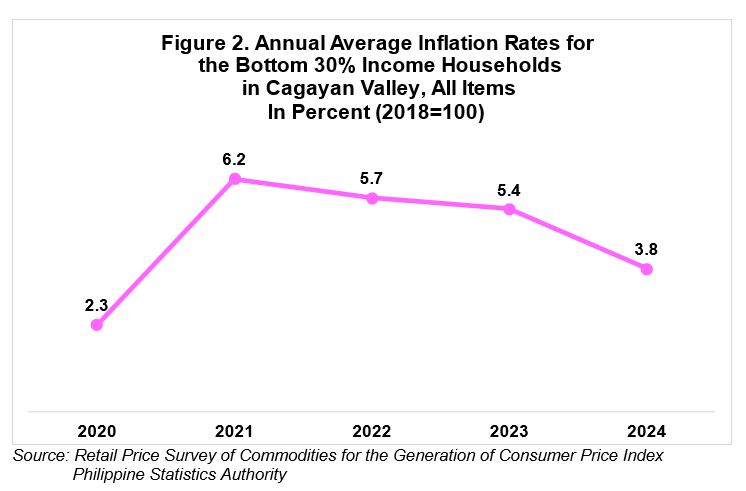
In terms of the region’s annual average inflation rate for the bottom 30% income households, it went down to 3.8 percent in 2024 from 5.4 percent in 2023.
The main driver of the downtrend of the annual average inflation for this income group in 2024 was the lower annual average growth rate of the food and non-alcoholic beverages at 5.8 percent during the year in review from 8.2 percent in 2023. The annual average inflation of housing, water, electricity, gas and other fuels at -4.3 percent in 2024 from -2.2 percent in 2023 and alcoholic beverages and tobacco at 4.9 percent from 12.0 percent, also contributed to the decrease in annual average inflation.
In addition, lower annual average inflation rates were posted by the following commodity groups:
• Personal care, and miscellaneous goods and services, 4.4 percent from 6.5 percent;
• Furnishings, household equipment and routine household maintenance, 4.2 percent from 7.6 percent;
• Clothing and footwear, 3.8 percent from 5.4 percent;
• Health, 2.4 percent from 3.2 percent;
• Education services, 4.1 percent from 6.1 percent; and
• Information and communication, 0.2 percent from 0.4 percent.
Conversely, higher annual average inflation rates were noted in the indices of the following commodity groups in 2024 compared to 2023:
• Transport, 1.1 percent from 0.0 percent;
• Recreation, sport and culture, 6.4 percent from 4.7 percent; and
• Restaurants and accommodation services, 7.2 percent from 3.1 percent.
The indices of the rest of the commodity groups retained their respective previous year’s annual average inflation rates.
_________________________________________________________________________
Note: CPIs and inflation rates by province and selected city are posted at the PSA OpenSTAT Portal at (https://openstat.psa.gov.ph/).
ENGR. GIRME M. BAYUCAN
(Chief Statistical Specialist)
Officer-in-Charge, PSA-RSSO II
//EMDP/MJCC/MLLP/SJCP
